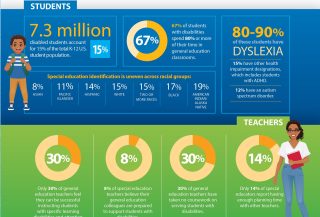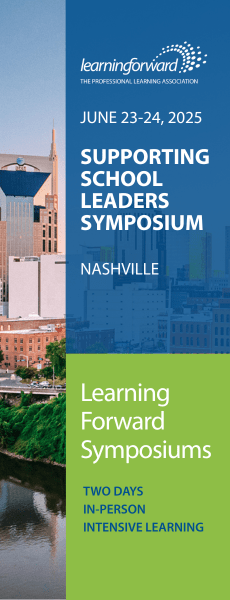FOCUS
Improve professional learning for the ‘hidden half.’ ONLINE EXCLUSIVE
By Danica Brown
Categories: Collaboration, Reaching all students, School leadership, Standards for Professional LearningAugust 2023
When education leaders think about professional learning, they usually picture teachers working with their peers to improve their instructional practice. But what about schools’ other employees, who also play vital roles in students’ learning, well-being, and achievement?
Educators like paraprofessionals, school counselors, librarians, and school and district leaders comprise about 52% of school personnel in the U.S. (National Center for Education Statistics, 2021), and their salaries and benefits account for about one-quarter of schools’ operating budgets (Richmond, 2014). Yet they receive much less attention among leaders, researchers, and policymakers compared to teachers (Finn, 2014), including in professional learning. These educators are sometimes referred to as the “hidden half” (Richmond, 2014).
These educators’ work is essential to many aspects of schools, and they share responsibility with teachers for ensuring student success. High school counselors, for instance, support students in numerous ways with academics, mental health, and postsecondary planning and preparation for college and their futures. Paraprofessionals typically provide academic and other forms of support to students with the greatest needs while assisting teachers with their classrooms and being called on by school leaders to engage in other tasks. Their contributions to student achievement and post-secondary success are noteworthy but rarely noted.
However, these educators rarely have opportunities for professional learning or structured time to collaborate, develop, and grow professionally alongside their colleagues, which research has shown has positive impacts on student learning (Blank & de las Alas, 2009). According to a nationally representative Education Week survey, in 2022, 42% percent of paraprofessionals reported that they don’t have access to enough professional learning for their jobs, with 13% not having participated in any professional learning at the time of the survey (Will, 2022).
Non-teaching or support staff in a school are sometimes called the ‘’hidden half.’’ 42% percent of surveyed paraprofessionals reported not enough access to professional learning. 13% had not participated in any PL. Share on XCompounding the problem, these professionals often work in isolation, due, in part, to organizational structures that keep their tasks and time siloed. Standards for Professional Learning underscore the fact that professional learning needs vary by role (Learning Forward, 2022). Thus, nonteacher educators need meaningful opportunities for collaboration and professional learning with their peers that are relevant to their roles and work.
Missing learning opportunities
Why don’t educators other than teachers have opportunities for structured professional learning? And what can be done to ensure that they have these opportunities? My interest in these questions emerged from a multiple case study of high school college-going culture and the support provided to students by both teachers and nonteacher staff in four greater New Orleans, Louisiana, public high schools (Brown, 2022).
In this study, I found that the school with the strongest college-going culture intentionally emphasized staff collaboration. They did so in two primary ways: first, by prioritizing time for it in staff schedules, and second, by structuring departments to provide numerous opportunities for collaborative professional learning and growth, especially among counselors. And at schools with weaker support structures for college-going, counselors cited a lack of opportunities for reflection and collaboration as barriers to providing more robust support for students.
These findings prompted me to look more deeply into the lack of professional learning for educators other than teachers, both in the four schools I studied and in the literature more broadly. I identified three often-overlooked reasons that contribute to the lack of adequate professional learning opportunities for the hidden half.
- Hidden-half educators are not teachers of record, so their time is viewed as unstructured and flexible.
Since they don’t teach classes (or, in some cases, support teachers who don’t have full responsibility for the classroom), these staff members are often seen as available to handle the immediate needs that arise in schools like substitute teaching, lunch duty, and hall monitor. With these shifts in roles and demands on their time, some counselors in my study reported feeling disrespected, unseen, and unheard by their school leaders and teaching colleagues.
Similarly, a survey indicated that 22% of paraprofessionals didn’t feel respected by their school staff (Will, 2022). This not only leads to frustration and inability to fulfill these professionals’ official roles, it also limits time for professional learning and reinforces erroneous notions that these educators do not need professional learning.
- Hidden-half educators typically have few peers in their schools and few organizational structures that promote collaboration.
Many hidden-half staff are the only ones at their schools in their role. For example, schools typically have one dean, one reading interventionist, or one social worker. This can feel isolating and make meaningful collaborative learning difficult. Even when there are multiple staff in similar roles, they can feel isolated if their tasks are structured very differently.
For example, even though high schools tend to have multiple counselors, their tasks may not overlap when departments are structured by grade level. This leads to counselors working in isolation on what’s relevant to the students they support. One 12th-grade counselor in my study bemoaned the lack of time for counselors to eat lunch together, “bounce ideas off each other,” and plan together to discuss what’s coming up because their schedules differed.
- Research on the effective practices of the hidden half is limited.
Much educational research focuses on teachers. As a result, we know less about best practices for and impact of the work of the hidden half. That makes professional learning foci and initiatives both less clear and less visible than those for teachers. This, in turn, can lead to low levels of self-efficacy among members of the hidden half.
I spoke with a former paraprofessional about whether and how more professional learning could have impacted her work. Her responses aligned with data from the Education Week survey. She felt that inadequate professional learning contributed to a lack of preparedness and effectiveness in her role. She didn’t understand leaders’ expectations of her or how to improve in her role. Moreover, limited professional learning signaled to her that she wasn’t an important part of the school. She said she would have felt more respected professionally among her teacher colleagues if she had structured opportunities for learning and collaboration with other paraprofessionals.
Recommendations for leaders
Given these reasons for limited professional learning for the hidden half, I offer three recommendations to school and district leaders to begin prioritizing professional learning for educators other than teachers.
- Devote structured time to the professional learning of all educators, tailored by role.
Some hidden-half staff are expected or even required to participate in professional learning in their schools, but they rarely find content that is relevant to their roles. For example, some paraprofessionals have opportunities to engage in learning with teachers, but paraprofessionals have different responsibilities and may work with specific populations of students whose needs are not addressed in the learning. They, like all educators, each need intentional time and space for their unique role to best support students and colleagues and thereby improve student learning.
- Prioritize the voices of the hidden half and collaborate with them to design professional learning.
School and district leaders should take time to listen to and learn from educators who are not teachers to understand their unique professional learning needs. One way to do this is to engage them in continuous improvement methods to study their own practices and document what is working and not working. (To learn more about continuous improvement methods, see the June 2023 issue of The Learning Professional on the theme “Improving Together.”) This can lay the groundwork for developing strategic goals and plans for the kinds of professional learning that can lead to improved practice and effectiveness. This process must be done with them, not for them.
- Structure departments to support ongoing collaborative professional learning.
Improving collaboration is not just about making time for meetings and professional learning communities. Collaboration should also happen informally to deepen and drive the learning during structured sessions.
My research found that counselors were very interested in collaborating and recognized that their effectiveness as counselors depended on it. But organizational structures shaped their ability to collaborate — sometimes positively and sometimes negatively. School and district leaders should consider structuring departments (or roles and responsibilities for individuals) to create task overlap as well as schedules for collaboration. Multiple people working on similar tasks create opportunities for shared problem-solving.
My research found that time for collaborative learning is critical for all educators, not just teachers. Building a culture of collaboration and learning can lead to a shared sense of responsibility for student success and stronger support for students. By paying attention to the learning and growth of the hidden half, we can better recognize them as vital contributors to our school communities and ensure that they are prepared to support student success.
Collaborative learning is critical for all educators. Prioritize the voices of support staff in a school and collaborate with them to design professional learning. #EdResearch #educators Share on XReferences
Blank, R.K. & de las Alas, N. (2009). The effects of teacher professional development on gains in student achievement: How meta analysis provides scientific evidence useful to education leaders. Council of Chief State School Officers.
Brown, D.R. (2022). Organizational contexts matter: A multiple case study of college-going culture and counselors in charter and traditional public high schools [Doctoral dissertation, Tulane University]. ProQuest Dissertations Publishing.
Finn, C.E. (2014, August 15). The hidden half: School employees who don’t teach. Education Next. www.educationnext.org/hidden-half-school-employees-dont-teach/
Learning Forward. (2022). Standards for Professional Learning. Author.
National Center for Education Statistics. (n.d.). Digest of Education Statistics: 2021. National Center for Education Statistics. nces.ed.gov/programs/digest/d21/tables/dt21_213.40.asp
Richmond, M. (2014). The hidden half: School employees who don’t teach. The Thomas B. Fordham Institute. fordhaminstitute.org/national/research/hidden-half-school-employees-who-dont-teach
Will, M. (2022, June 15). Paraprofessionals: As the “backbones” of the classroom, they get low pay, little support. Education Week. www.edweek.org/leadership/paraprofessionals-as-the-backbones-of-the-classroom-they-get-low-pay-little-support/2022/06

Danica Brown (danica.brown@wayne.edu) is a postdoctoral research fellow at Wayne State University.
Categories: Collaboration, Reaching all students, School leadership, Standards for Professional Learning
Recent Issues
LEARNING DESIGNS
February 2025
How we learn influences what we learn. This issue shares essential...
BUILDING BRIDGES
December 2024
Students benefit when educators bridge the continuum of professional...
CURRICULUM-BASED PROFESSIONAL LEARNING
October 2024
High-quality curriculum requires skilled educators to put it into...
LEARNING TO PIVOT
August 2024
Sometimes new information and situations call for major change. This issue...












